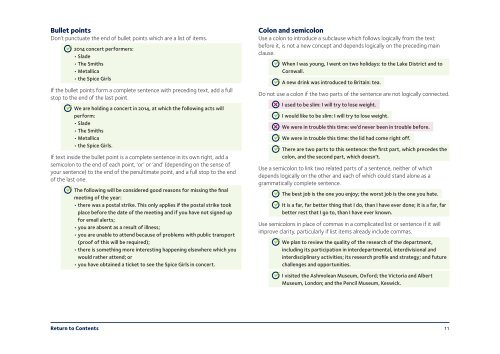University of Oxford Style Guide
University of Oxford Style Guide
University of Oxford Style Guide
Create successful ePaper yourself
Turn your PDF publications into a flip-book with our unique Google optimized e-Paper software.
Bullet pointsDon’t punctuate the end <strong>of</strong> bullet points which are a list <strong>of</strong> items.2014 concert performers:• Slade• The Smiths• Metallica• the Spice GirlsIf the bullet points form a complete sentence with preceding text, add a fullstop to the end <strong>of</strong> the last point.We are holding a concert in 2014, at which the following acts willperform:• Slade• The Smiths• Metallica• the Spice Girls.If text inside the bullet point is a complete sentence in its own right, add asemicolon to the end <strong>of</strong> each point, ‘or’ or ‘and’ (depending on the sense <strong>of</strong>your sentence) to the end <strong>of</strong> the penultimate point, and a full stop to the end<strong>of</strong> the last one.The following will be considered good reasons for missing the finalmeeting <strong>of</strong> the year:• there was a postal strike. This only applies if the postal strike tookplace before the date <strong>of</strong> the meeting and if you have not signed upfor email alerts;• you are absent as a result <strong>of</strong> illness;• you are unable to attend because <strong>of</strong> problems with public transport(pro<strong>of</strong> <strong>of</strong> this will be required);• there is something more interesting happening elsewhere which youwould rather attend; or• you have obtained a ticket to see the Spice Girls in concert.Colon and semicolonUse a colon to introduce a subclause which follows logically from the textbefore it, is not a new concept and depends logically on the preceding mainclause.When I was young, I went on two holidays: to the Lake District and toCornwall.A new drink was introduced to Britain: tea.Do not use a colon if the two parts <strong>of</strong> the sentence are not logically connected.I used to be slim: I will try to lose weight.I would like to be slim: I will try to lose weight.We were in trouble this time: we’d never been in trouble before.We were in trouble this time: the lid had come right <strong>of</strong>f.There are two parts to this sentence: the first part, which precedes thecolon, and the second part, which doesn’t.Use a semicolon to link two related parts <strong>of</strong> a sentence, neither <strong>of</strong> whichdepends logically on the other and each <strong>of</strong> which could stand alone as agrammatically complete sentence.The best job is the one you enjoy; the worst job is the one you hate.It is a far, far better thing that I do, than I have ever done; it is a far, farbetter rest that I go to, than I have ever known.Use semicolons in place <strong>of</strong> commas in a complicated list or sentence if it willimprove clarity, particularly if list items already include commas.We plan to review the quality <strong>of</strong> the research <strong>of</strong> the department,including its participation in interdepartmental, interdivisional andinterdisciplinary activities; its research pr<strong>of</strong>ile and strategy; and futurechallenges and opportunities.I visited the Ashmolean Museum, <strong>Oxford</strong>; the Victoria and AlbertMuseum, London; and the Pencil Museum, Keswick.Return to Contents11


